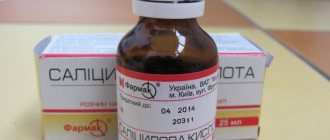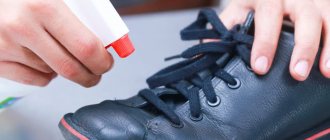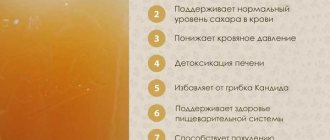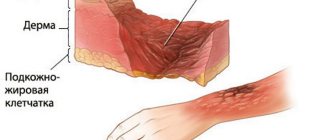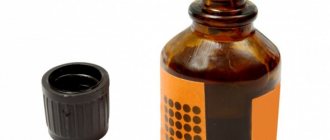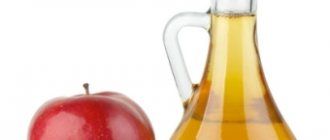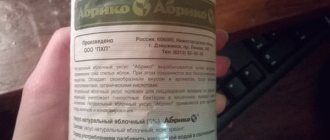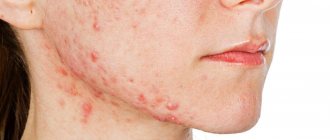Acetic acid burn: pathogenesis
The cause of burns from acetic acid is mainly careless handling of the solution. A particularly high concentration of the substance causes immediate damage to organs. Lesions can be of two types:
- External. When it comes into contact with a person’s external organs, the acid causes immediate corrosion of the skin or mucous membranes. And without first aid, complications may arise that will lead to longer treatment.
- Internal. Such injuries pose a particular danger to humans. The penetration of acetic acid into internal organs has serious consequences and requires immediate medical treatment.
Severe burns from a highly concentrated solution can cause death to the victim.
Degree of acetic acid burn
The nature of the damage depends on the amount and concentration of acetic acid ingested and the duration of contact with it.
There are different degrees of burns:
- First. Refers to mild lesions. It is characterized by superficial redness of the skin tissue, which may be accompanied by swelling and pain. In most cases it is treated quite quickly. After therapeutic actions there are no traces of burns left.
- Second. Along with the top cover, the germ layer of the epidermis is damaged. The formation of blisters on the skin is observed, which subsequently form a wound. Healing occurs over several weeks.
- Third. A deeper lesion, covering all layers of the skin. The wound consists of purulent discharge, clotted blood and dead cells. Requires long-term hospital treatment, the success of which depends on the first actions after the burn. Such injuries leave scars and scars.
- Fourth. The most dangerous form of pathology. Occurs upon contact with a strong acid solution. With such lesions, all skin cells die. The success of treatment depends on the size of the affected areas and the characteristics of the patient’s immune defense.
In the most severe cases, first aid and the timely arrival of an ambulance can save the victim’s life.
Symptoms of damage to different parts of the body
The list of symptoms from the effects of vinegar on the body depends on the area of the skin that was injured, its area and the duration of contact with the acid. It happens that unpleasant signs do not appear immediately, but only after some time. This happens especially often when acid has spilled onto clothing that has been in contact with the skin for quite a long time.
Without proper and timely assistance, a vinegar burn can lead to the death of a person if a large area of the body is affected.
The consequence of contact with the essence of the skin on the face is usually the formation of a scab. This is a thin but dense crust that prevents the penetration of aggressive chemicals into the deeper layers of tissue.
Symptoms depending on the location of the burn
Acetic acid can get on both external and internal human organs. Damage to different parts of the human body has distinctive symptoms.
Leather
A light spot initially forms on the area burned with acid. It quickly darkens and acquires a gray tint. The injured area of the skin begins to hurt and a burning sensation is felt.
The skin becomes dry and a crust appears with clear contours that separate healthy and diseased tissue.
Acetic acid burn: oral cavity
If a solution of strong concentration comes into contact with the solution, severe pain and tissue damage occurs. The oral cavity turns white and begins to swell. There is copious secretion of saliva. Speech becomes difficult.
Acetic acid burn: larynx
The first sign of a burn to the larynx is a sharp pain and burning sensation. Vomiting and strong secretion of salivary gland secretions begin. The lips and oral cavity swell. Body temperature rises and lymph nodes enlarge.
The first sign of a burn to the larynx is a sharp pain and burning sensation.
Severe injuries can cause suffocation for the victim.
Acetic acid burn: esophagus
A burn to part of the digestive canal causes pain in the chest, neck and upper abdomen. This is due to the fact that internal organs have many nerve endings.
Damage to the esophagus is accompanied by nausea and vomiting. The tissues of the organ swell, affecting the vocal cords. Such symptoms interfere with normal swallowing of saliva and negatively affect the victim’s speech. Body temperature increases.
Airways
Acetic acid enters the respiratory system in the form of hot vapors. The nature of the lesions depends on the saturation of the inhaled solution. The first signs of a burn are a suffocating, continuous cough and runny nose. Tears begin to flow and it becomes difficult to breathe air.
The first signs of a burn are a suffocating, continuous cough.
With severe damage from acetic acid, intoxication of the human body occurs, which can cause a state of shock. In such cases, signs of acute toxic psychosis, shortness of breath and tachycardia are often observed. Over time, concomitant diseases appear - pancreatitis, gastritis or pneumonia. The body's protective functions are significantly reduced.
Providing first emergency aid
Correctly provided assistance in the first minutes of a burn field not only promotes rapid healing of wounds, but can also save the life of the victim.
For external burns
If vinegar gets on the outside of your body, the first step is to remove clothing from the affected area. Subsequent actions for vinegar burns consist of the following steps:
- burned areas are washed with cold water for 20 minutes;
- the skin is treated with soda or soap solution dissolved in water;
- after cleansing the affected area, wash off with clean cool water;
- an antiseptic and anti-inflammatory agent is applied;
- a dry sterile bandage is applied.
If you burn with acetic acid, do not forget to apply a dry, sterile bandage.
For minor injuries, the main goal of first aid is to relieve pain, redness and swelling. You can continue to treat such injuries at home. Serious injuries require immediate hospitalization.
For internal burns
When acetic acid gets ingested, the main task is to immediately neutralize the toxic substance.
If the solution falls into the throat, rinse all affected areas, including the oral cavity, with baking soda diluted in water. A burn to the esophagus requires more complex measures. In addition to rinsing, immediate gastric lavage is required. For this, more than five liters of clean water are used. You should not give the soda solution to the victim to drink; such a mixture can further destroy the affected tissue areas.
Internal burns are much more dangerous than external injuries caused by acetic acid. Therefore, after providing first aid, professional examination and treatment are required.
How to eliminate the smell of vinegar in a room?
If you accidentally spilled vinegar on the floor while cleaning, or used it as a disinfectant, getting rid of the unpleasant odor is not difficult. First of all, you will need to ventilate the room and carry out wet cleaning with chemicals.
Ventilation
Getting the unpleasant smell of vinegar out of a room can be difficult, especially if a large amount has been spilled. To achieve the result, open all windows and interior doors. Ventilate the room for 3-4 hours. If the smell cannot be completely eliminated at one time, the ventilation procedure is repeated after some time.
Wet cleaning of the premises
Wet cleaning of the room will help eliminate the unpleasant smell of vinegar. Add a special floor cleaner or a small amount of dishwashing detergent with a pleasant aroma to a bucket of water. Rinse the floors thoroughly and let dry. Instead of detergent, you can add a few drops of essential oil to the water.
Baking soda and salt have the ability to absorb foreign odors. In a room where there is a strong aroma of vinegar, place open jars of these products.
Acetic acid burn: diagnosis
The nature of an external burn can be determined by changes in the color of the skin and the specific smell of the affected area. Based on external indicators, wounds are assessed and the degree of the pathological process is determined. The situation with internal burns is somewhat more complicated.
To establish intoxication of the body with acetic acid, anamnesis data are initially collected, including a visual examination of the patient. The main indicator of a burn of internal organs by vinegar is the presence of a characteristic odor from the oral cavity.
To establish the final diagnosis and the extent of the lesion, a general blood test is prescribed.
To establish the final diagnosis and the extent of the lesion, the following additional study is prescribed:
- a general blood test that determines the level of ESR and C-reactive protein;
- fluoroscopic examination.
If the mucous membrane of the eyes is damaged, an additional consultation with an ophthalmologist is carried out.
Eliminating stink from shoes
Often they try to remove the smell of sweat from shoes with a vinegar solution. This method is very effective, but after processing a completely different aroma appears. Then another question arises, how to remove the stink from vinegar?
Ammonia will help solve the problem. To do this, you need to treat the solution from the inside and outside. As soon as the smell changes, you need to soak a cotton pad in ammonia and place it on the insole. At night, treated shoes should be placed on the balcony.
Treatment depending on the location and degree of the burn
Treatment methods are determined by the severity of the damage. For both internal and external lesions, the first step is to eliminate pain, and also take measures to stop the pathological process.
External burns
If the skin is damaged by acetic acid, the area is initially disinfected with antiseptic agents. In parallel with this, healing ointments are used.
For higher degree burns, antibiotics and antihistamines are prescribed. Serious injuries are accompanied by intense pain that can cause shock. In such cases, painkillers and antispasmodics are necessarily prescribed.
The most effective medications against burns include the following ointments:
- "Levomekol";
- "Panthenol";
- "Dermazin";
- "Rescuer";
- "Solcoseryl".
The most effective medications against burns include levomekol.
The duration of therapy depends on the size of the affected tissue and the degree of the burn. When all tissues of the skin or mucous membranes are affected, surgical intervention is sometimes necessary. The operation is aimed at removing dead tissue. After this, plastic surgery can be performed.
The burn site should not be treated with iodine, brilliant green or preparations containing alcohol. Such substances contribute to greater destruction of skin tissue.
Internal burns
Internal organ damage has another treatment:
- Oral cavity. The doctor prescribes antiseptics as a rinse and treatment of sore areas with wound-healing ointments. Solcoseryl Denta dental paste helps well in such cases. For severe pain, painkillers are taken.
- Larynx. Treatment is with antihistamines, which help reduce swelling of the throat. Medicines are also used to relieve pain symptoms. Antispasmodics are prescribed along with them.
- Esophagus. Treatment of such damage to the tissues of the digestive part cannot be done without pain-relieving drugs, bacteria-killing drugs and antispasmodics. For severe burns of the esophagus, additional therapy for the cardiac and respiratory systems is required.
Along with drug therapy, the patient is prescribed a special diet. If the larynx and organs of the digestive tract are affected, it is recommended to consume soups or pureed foods.
Therapeutic actions should be carried out immediately after the injury. Six hours after a vinegar burn, therapy may no longer be effective. Therefore, it is especially important to consult a doctor in a timely manner for help.
Traditional methods of treatment
For burns with acetic acid, various traditional methods of therapy are successfully used, which accelerate the healing process of damaged tissues and have a softening and calming effect.
The most effective alternative medicines include:
- Oak bark. Pour 3 tablespoons of crushed oak bark into a container with one liter of water and cook over low heat for 30 minutes. Cool the finished broth and strain. Liquid is used for compresses. It should only be used freshly prepared.
- Potato. Peel the vegetable and grate it on a fine grater. Apply the resulting potato mass to the affected skin for 25 minutes. This procedure should be repeated twice a day.
- Hornbeam elm. Add one tablespoon of finely chopped elm bark to 200 milliliters of water. Boil the solution for 20 minutes over low heat. Use the cooled and strained broth for lotions. Apply the product to the wound at least three times a day.
- Aspen bark. Pour one tablespoon of crushed bark into a container with a lid and pour 400 milliliters of boiling water. Let the mixture sit for an hour. After this, the liquid saturated with aspen bark must be filtered and diluted with a glass of boiled water. Take the infusion three times a day, two tablespoons at a time. The medicine should be taken with meals.
- Mint. Pour a tablespoon of finely chopped mint into 200 milliliters of hot water and leave in a container with the lid closed to steep for 45 minutes. The strained solution is used to make lotions three times a day.
- Aloe. Squeeze the juice from the leaves of the plant, which is used to treat damaged areas of the skin. You can also apply aloe leaves, cut lengthwise with the fleshy side, to the wound.
- Beeswax. The waste product of bees is added to the butter in a 3:1 ratio. Stir the mixture in a water bath until the ingredients are completely dissolved. The cooled ointment is applied to the areas burned with vinegar, a gauze bandage is placed on top and left for two hours.
Traditional methods of treatment are used only for first-degree burns that do not have purulent formations and damage to the lower layers of the epidermis. For severe injuries caused by acetic acid, drug therapy is required, which is prescribed by a doctor. Self-treatment of such burns can lead to complications.
Consumer Reviews
Cherry The Countess (irecommend.ru)
Reading my review of the cream from the Propeller brand, I promised to tell you about another product to combat acne, inflammation and flaking. My favorite in this matter at the moment is La Cree cream.
La-Cri cream for sensitive skin photo
It is intended to relieve irritation, itching and redness. But I found it useful in treating my imperfect skin.
This cream has a natural composition.
- Avocado oil – has a moisturizing effect and heals wounds
- Licorice extract – has anti-inflammatory and anti-allergic effects
- Walnut extract – antibacterial, wound healing effect
- Bisabolol – calming effect
- Violet extract – anti-allergenic, soothing effect
- Seed extract – antimicrobial, wound healing, antiallergic effect
- All these components provide a quick and visible effect of application.
The cream is very thick, green-brown in color, which confirms the naturalness of the composition.
Directions for use: Apply to dry, clean facial skin 1-2 times a day. I use 2 times, in the morning after washing and in the evening after removing makeup.
Prevention
The main objective of preventive measures is to comply with safety rules when using acetic acid, which include:
- storing concentrated vinegar out of the reach of children;
- use gloves when diluting high concentration acid.
The container with vinegar must have a label indicating the name of the substance. If acid accidentally comes into contact with your skin, you should immediately take all necessary measures to reduce its effect on the body. See a doctor immediately after getting a burn.
How to get rid of vinegar smell on hands?
After cooking or general cleaning, an unpleasant smell of vinegar remains on the skin of your hands, which salt will help get rid of. You will need to prepare a water-salt solution by mixing a small amount of warm water and salt, put your hands in it for 5 minutes. Then wash your hands under running water.
Chemical odor removers
If the smell of vinegar turns out to be very persistent and you can’t deal with it with improvised means, we recommend using professional household chemicals.
“Cristal” are specialized salt crystals from various manufacturers, designed to eliminate unpleasant odors in the refrigerator and room.
How to use: Place the product near the place where the smell is strongest. Leave the crystal in this place until the smell of vinegar disappears completely.
"Urine off Multi-Purpose." Organic odor remover. Sold as a spray, it is convenient to use for treating upholstered furniture, carpets, shoes, clothing, wood and tile floors.
“Allergy free” means for eliminating unpleasant odors of organic origin. Suitable for use on any surface. The product PIP Allergy free is recommended for people with allergies.
"Magos Dream JSC". A liquid product used to eliminate unpleasant odors in various types of premises.
"Odorgone Animal Gold" is an effective product for eliminating pet odor and is also effective for eliminating the unpleasant odor of vinegar. The product needs to be sprayed onto the foul-smelling area; after the spray is absorbed, the smell will disappear.
Important: all the products described above are made on the basis of safe and highly effective components; when using, it is important to strictly follow the instructions and avoid contact with mucous membranes and skin.
Forecast
In case of mild tissue damage from acetic acid, after first aid, the patient is sent for home treatment. In such cases, healing occurs quickly and no trace remains of the burn.
Severe injuries, which are characterized by third and fourth degrees, have a mortality rate of 60 percent. The result of treatment depends on the amount of damage and the quality of care provided in the first minutes after the burn. Acid injuries to internal organs are especially dangerous.
An eye burn with a mildly saturated vinegar solution has a favorable prognosis. If measures were quickly taken to eliminate the acid, then 90 percent of vision is not impaired. With severe burns of the mucous membrane of the eye, solders often form, which lead to blindness.
An acid burn is a dangerous injury that can significantly harm a person’s health. To avoid irreparable consequences, you should carefully use the vinegar solution, especially in high concentration. In case of accidental damage to the skin or other organs, even mildly, you should immediately consult a doctor. Prompt assistance from a specialist can save not only your health, but also your life.
How to remove vinegar smell from clothes?
If table vinegar was used as a stain remover, there is a high probability that the clothes will emit an unpleasant aroma. Machine washing, ammonia or baking soda will help get rid of the smell.
Washing machine. If the aroma is weak, then washing with powder and fabric softener in an automatic machine can solve the problem.
Important: when choosing a washing mode, consider the composition of the fabric.
Ammonia. Add a small amount of ammonia to a container with water, stir thoroughly, put clothes in the solution, and leave for 30 minutes. Then rinse the items thoroughly and dry in the fresh air.
Baking soda. Dissolve a small amount of soda in warm water, immerse the items in the resulting solution for 1-2 hours.
Important: you cannot use a water-soda solution for synthetic products; the fabric may fade or become faded.
